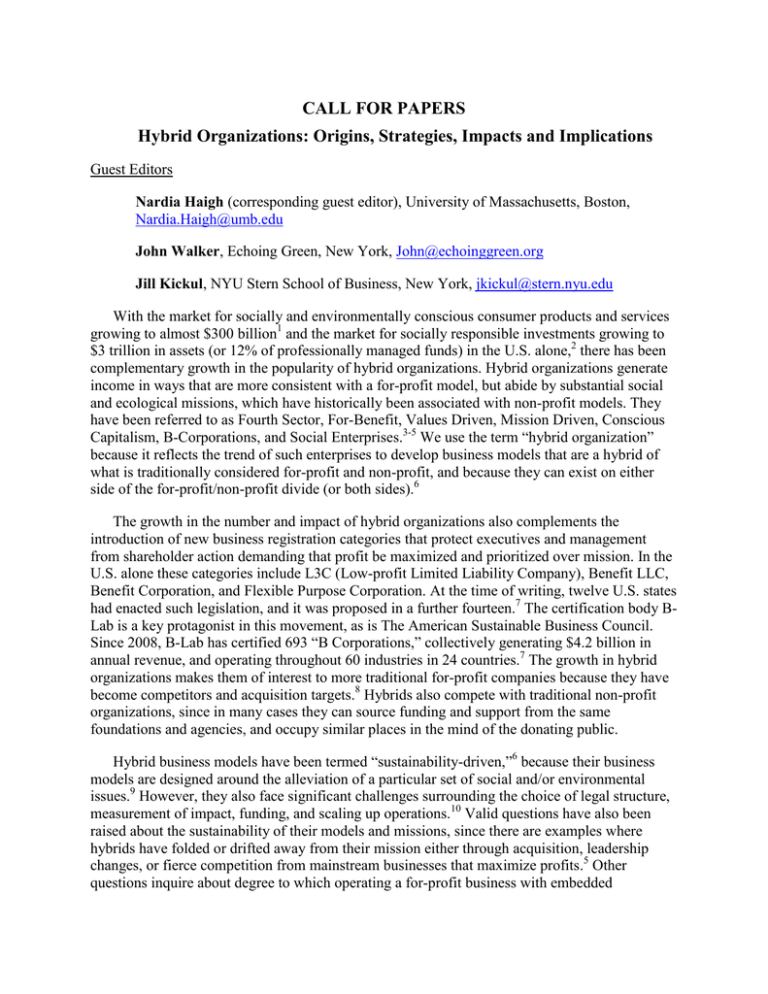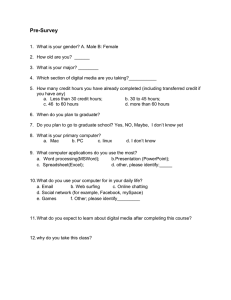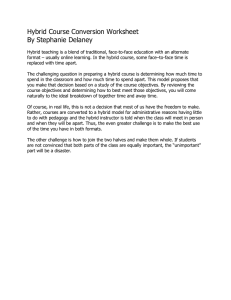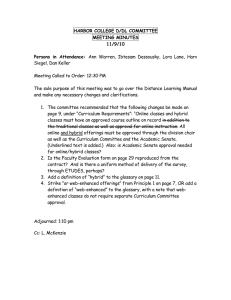CALL FOR PAPERS Hybrid Organizations
advertisement

CALL FOR PAPERS Hybrid Organizations: Origins, Strategies, Impacts and Implications Guest Editors Nardia Haigh (corresponding guest editor), University of Massachusetts, Boston, Nardia.Haigh@umb.edu John Walker, Echoing Green, New York, John@echoinggreen.org Jill Kickul, NYU Stern School of Business, New York, jkickul@stern.nyu.edu With the market for socially and environmentally conscious consumer products and services growing to almost $300 billion1 and the market for socially responsible investments growing to $3 trillion in assets (or 12% of professionally managed funds) in the U.S. alone,2 there has been complementary growth in the popularity of hybrid organizations. Hybrid organizations generate income in ways that are more consistent with a for-profit model, but abide by substantial social and ecological missions, which have historically been associated with non-profit models. They have been referred to as Fourth Sector, For-Benefit, Values Driven, Mission Driven, Conscious Capitalism, B-Corporations, and Social Enterprises.3-5 We use the term “hybrid organization” because it reflects the trend of such enterprises to develop business models that are a hybrid of what is traditionally considered for-profit and non-profit, and because they can exist on either side of the for-profit/non-profit divide (or both sides).6 The growth in the number and impact of hybrid organizations also complements the introduction of new business registration categories that protect executives and management from shareholder action demanding that profit be maximized and prioritized over mission. In the U.S. alone these categories include L3C (Low-profit Limited Liability Company), Benefit LLC, Benefit Corporation, and Flexible Purpose Corporation. At the time of writing, twelve U.S. states had enacted such legislation, and it was proposed in a further fourteen.7 The certification body BLab is a key protagonist in this movement, as is The American Sustainable Business Council. Since 2008, B-Lab has certified 693 “B Corporations,” collectively generating $4.2 billion in annual revenue, and operating throughout 60 industries in 24 countries.7 The growth in hybrid organizations makes them of interest to more traditional for-profit companies because they have become competitors and acquisition targets.8 Hybrids also compete with traditional non-profit organizations, since in many cases they can source funding and support from the same foundations and agencies, and occupy similar places in the mind of the donating public. Hybrid business models have been termed “sustainability-driven,”6 because their business models are designed around the alleviation of a particular set of social and/or environmental issues.9 However, they also face significant challenges surrounding the choice of legal structure, measurement of impact, funding, and scaling up operations.10 Valid questions have also been raised about the sustainability of their models and missions, since there are examples where hybrids have folded or drifted away from their mission either through acquisition, leadership changes, or fierce competition from mainstream businesses that maximize profits.5 Other questions inquire about degree to which operating a for-profit business with embedded consciousness could ever be widely applied or achieve the sustained societal and environmental transformation for which they strive.5 The goal of this special issue is to stimulate authors to consider the rise of hybrid organizations, the ways in which they create and track the shared value to which they aspire, and the degree to which these models are sustainable over the long-term. Perhaps more significantly, we aim to offer valuable content focusing on the implications (positive and negative) of hybrid models for the management of traditional businesses and hence CMR’s audience. To date, only anecdotal evidence has been presented about how hybrids have influenced their competitors and industry bodies (e.g., the role Maggie’s Organics had in establishing organic fiber processing standards in the American apparel industry6). We aim to attract papers based on scholarly studies, and invite submissions that address (but are not limited to) the following topics and suggested research questions: Origins and significance of hybrid organizations o What explains their growth and popularity? o Are they a force or a fad? Strategies of and challenges surrounding hybrid organizations: o How are hybrid organizations addressing mission drift, scalability, financing and other known challenges they face? o What are the advantages and disadvantages of choosing variations of the LLC form (e.g., L3C, CIC, and Benefit LLC) or variations of corporate form (e.g., Benefit Corporation, flexible purpose corporation) over their original forms? o How do hybrid organizations compare in purpose, strategies and models between developing and developed markets? Measurement of social impact and performance: o What impact do hybrid organizations have on their focal issues? Are there differences in impact between industries, markets, regions, etc.? o Do hybrid organizations perform better than their traditional for-profit or non-profit counterparts in terms of social impact and financial performance? o What issues surround the measurement of social impact, and how are they overcome? Implications of hybrids for management: o What implications do hybrid organizations carry for the management of traditional forprofit business models? o What implications do they carry for management in the non-profit sector? o How do traditional companies and non-profits compete with hybrid organizations? For example: Are hybrids perceived as a force or a fad? To what degree (if any) are traditional companies and non-profits altering their strategies or even their models to compete with hybrid organizations? Submission and Deadlines To submit your manuscript for this special issue, please email your paper to nardia.haigh@umb.edu by October 31, 2013. All papers should meet the content and style guidelines of CMR, which can be found here: http://cmr.berkeley.edu/submission_guidelines.html. Most critical to understand is that CMR’s readership is split between BOTH academicians and practitioners, so all papers must be both academically sound and offer relevant, prescriptive advice for practicing managers. All submissions will be reviewed following CMR’s review process. Final decisions about publication will be made by the CMR editorial team. For further information, please contact the CMR co-guest editor for this special issue, Nardia Haigh: nardia.haigh@umb.edu. References 1. LOHAS. 2011. Lifestyles of Health and Sustainability. http://www.lohas.com/about, accessed 29 July 2011. 2. USSIF. 2010. Report: Socially Responsible Investing Assets in US Top $3 Trillion; Nearly 1 Out of Every 8 Dollars Under Professional Management. http://ussif.org/news/releases/pressrelease.cfm?id=168, accessed 12 August 2011. 3. Alter, K. 2004. Social Enterprise Typology. Seattle, WA: Virtue Ventures LLC. 4. Boyd, B., et al. 2009. Hybrid Organizations: New Business Models for Environmental Leadership. Sheffield: Greenleaf Publishing. 5. O'Toole, J. and D. Vogel. 2011. Two and a Half Cheers for Conscious Capitalism, California Management Review, 53/3: 60-76. 6. Hoffman, A.J., K.K. Badiane, and N. Haigh. 2012. Hybrid Organizations as Agents of Positive Social Change: Bridging the For-Profit & Non-Profit Divide, in Using a Positive Lens to Explore Social Change and Organizations: Building a Theoretical and Research Foundation, K. Golden-Biddle and J. Dutton, Editors, Routledge, Taylor and Francis Group. 7. B-Lab. 2012. Annual Report and website. http://bcorporation.net/, accessed 3 July 2012. 8. Haigh, N. and A.J. Hoffman. 2012. Hybrid organizations: The next chapter of sustainable business, Organizational Dynamics, 41: 126-134. 9. Nielsen, C. and P.M. Samia. 2008. Understanding key factors in social enterprise development of the BOP: a systems approach applied to case studies in the Philippines, Journal of Consumer Marketing, 25/7: 446-454. 10. Battilana, J., et al. 2012. In Search of the Hybrid Ideal, in Stanford Social Innovation Review: Stanford, United States, Stanford. p. 51-55.



